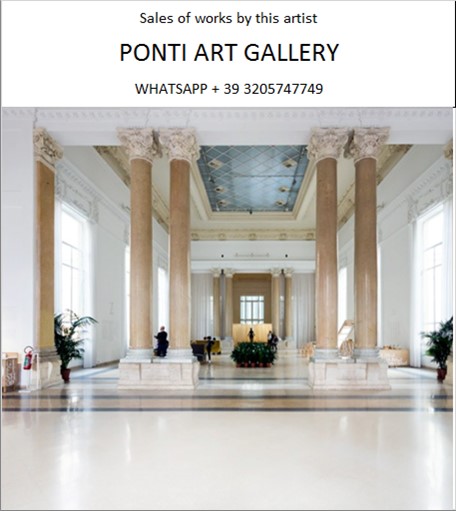Ponti Art Gallery is interested in buying and selling works
of art by this artist.

Robert Mangold Biography
Robert Mangold, born on October 12, 1937, in North Tonawanda, New York, is a distinguished American artist renowned for his contributions to the Minimalist movement. His work, characterized by an exploration of geometric abstraction and a restrained color palette, has played a significant role in shaping the discourse around Minimalism and abstract art since the 1960s. Mangold's artistic journey is a testament to his enduring commitment to the exploration of form, color, and composition, making him one of the most significant painters of his generation.
Mangold's early life was marked by a profound interest in art, nurtured by his family's support. His father, Aloysius Mangold, worked at an organ factory, and his mother, Blanche, was a department store buyer. Despite not coming from an artistically inclined family, Mangold's talent and passion for art were evident from a young age. He initially enrolled in the illustration department at the Cleveland Institute of Art in 1956 but soon transferred to the fine arts division, where he studied painting, sculpture, and drawing. This decision marked the beginning of his lifelong commitment to abstract art.
After completing his undergraduate studies, Mangold attended the Yale Summer School of Music and Art on a scholarship, a pivotal experience that introduced him to a community of like-minded artists. In the fall of 1960, he entered Yale's graduate school program in Art and Architecture, where he befriended future luminaries of the art world such as Nancy Graves, Brice Marden, and Richard Serra. It was during this period that Mangold began to experiment with large abstract canvases, laying the groundwork for his future explorations in Minimalism.
Mangold's early work was influenced by his experiences in New York City, where he moved after completing his M.F.A. in 1962. The city's industrial landscape, with its scale and color, provided a rich source of inspiration for Mangold. He took a position as a guard at the Museum of Modern Art, where he met fellow artists Sol LeWitt and Robert Ryman, who were also employed there. This environment fostered a sense of community and dialogue among the artists, further shaping Mangold's artistic vision.
Throughout the 1960s, Mangold's work evolved in response to the Minimalist movement. He was included in the seminal 1965 exhibition at the Jewish Museum in New York, which was the first major showcase of Minimal art. Mangold's paintings from this period are characterized by their simplicity and focus on geometric forms. He often worked with monochromatic palettes, exploring the subtle interplay between shape and color. His works from the late 1960s and early 1970s, such as the "Grey Window Wall" (1964), marked a significant departure from the more expressive tendencies of Abstract Expressionism, embracing instead a more restrained and conceptual approach.
In the 1980s, Mangold introduced brighter colors and more complex geometric configurations into his work, reflecting the influence of Post-Minimalism. Despite these shifts, his commitment to exploring the fundamental elements of painting remained constant. Mangold's work challenges traditional notions of what a painting can be, often blurring the lines between painting and sculpture.
Mangold's contributions to art have been recognized with numerous awards and honors, including a Guggenheim Fellowship in 1969 and inclusion in major exhibitions such as the Venice Biennale and the Whitney Biennial. His works are held in the collections of prestigious institutions worldwide, including the Museum of Modern Art in New York, the Solomon R. Guggenheim Museum, and the San Francisco Museum of Modern Art.
Beyond his individual achievements, Mangold's legacy includes his influence on younger generations of artists. His dedication to the craft of painting and his exploration of minimal forms have inspired countless artists to pursue their own investigations into the possibilities of abstract art. Mangold continues to live and work in Washingtonville, New York, with his wife, Sylvia Plimack Mangold, who is also an accomplished artist. Together, they have contributed significantly to the artistic landscape of the 20th and 21st centuries.
Robert Mangold Quotes and
Sales of Works
Ponti Art Gallery selects and deals with paintings by the
artist. Upon request, we provide free estimates and
evaluations, communicate prices, quotations, and current
market values.
If you are interested in BUYING or SELLING works by the
artist, contact us immediately.
If you wish to sell or receive an evaluation of the
works:
Send us a frontal photo of the painting, one of the back,
and one of the signature. Also, indicate the dimensions of
the work. Inform us about the purchase origin of the work
and any kind of available documentation (purchase
receipts, certificates of authenticity, publications). One
of our operators will respond to you on the same day. We
guarantee maximum confidentiality and extreme
professionalism.
If you wish to purchase works by the painter: Contact us
and let us know your request. We will inform you about the
available works. We also offer the possibility to
subscribe to our NEWSLETTER, through which you will be
informed at the beginning of each month about the latest
acquisitions of the art gallery.
You can send us pictures of the work:
